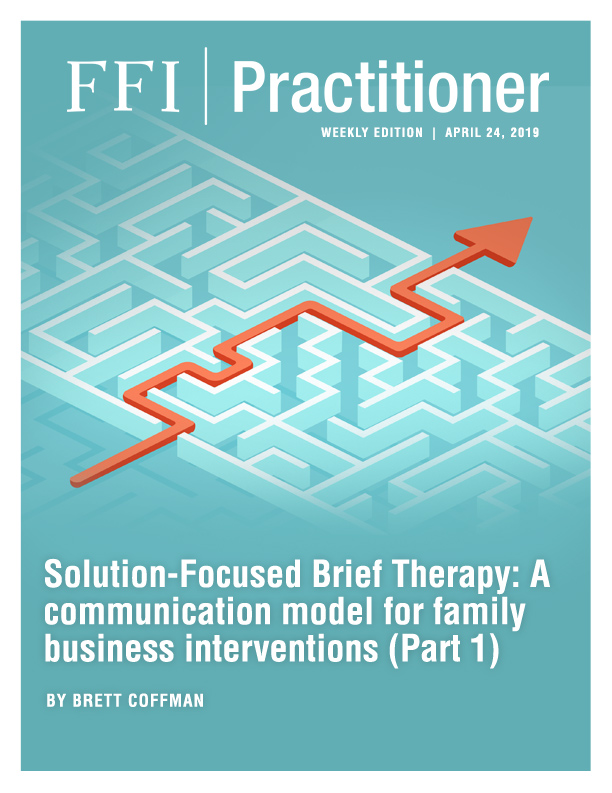Solution-Focused Brief Therapy: A communication model for family business interventions (Part 1)

This week’s FFI Practitioner begins a two-part examination of Solution-Focused Brief Therapy (SFBT), an evidence-based coaching and therapy model, and its potential application to help family enterprise members find solutions to a variety of challenges. Thanks to this week’s contributor, Brett Coffman for providing this analysis.
However, not all models or processes provide results consistently across a spectrum of client situations. Evidence-based theoretical models should provide a practice framework for family interventions that result in consistent application, issue resolution, and positive family and business interactions. Solution-Focused Brief Therapy (“SFBT”) is one well-tested coaching and therapy model that has been shown to provide positive long-term client outcomes. The principles and techniques can be applied successfully to challenges in family businesses by practitioners who seek to develop a solution-focused practice.
SFBT Defined and Contrasted
SFBT is a goal-oriented model which places the focus on a person’s present and future circumstances and goals rather than on past experiences. The issues that bring the client to an engagement are not typically the underlying target. Instead, the practitioner encourages clients to develop a vision of the future and offers support as they co-construct the skills, resources, and abilities needed to achieve that vision (Dolan & Pichot, 2003).
The SFBT model, typically used in individual and group settings, involves developing and achieving the client’s vision of solutions, based on his or her goals and perceived self-efficacy. The foundational premise is that clients know the problems they face and have many of the answers they seek. However, they need help articulating, organizing, and validating those answers. SFBT is most aligned with social constructionism, in which individuals mentally construct their world of experience, largely with categories supplied by social relationships (de Shazer & Dolan, 2007). As a result, SFBT is heavily focused on questions about the clients’ relationship with others and themselves.
The Beginning of the Solution-Focused Brief Therapy Conversation
There are three main ingredients to SFBT conversations. First, the overall topics. SFBT conversations are centered on client concerns, perceived self-efficacy, who and what are important to the clients, a vision of a preferred future, clients’ strengths and resources related to that vision, scaling of clients’ motivational level, helping them find the confidence to identify solutions, and ongoing scaling of clients’ progress toward reaching the preferred future.
Second, a coaching/therapeutic process of co-constructing altered or new meanings around events unfolding. This process comes into being largely by practitioners asking questions about the topics of conversation that are identified, connecting to and building from the clients’ responses.
Third, a number of specific responding and questioning techniques that invite clients to co-construct a vision of a preferred future and draw on their past successes, strengths, and resources to make that vision a reality.
“… [SFBT] can serve as a foundational model for interacting with families and their businesses for practitioners seeking to help clients move toward solutions to their most pressing issues.”
Application to Family Business
Through Meta-analysis reviews of worldwide studies, we know that SFBT has been used to treat the entire range of clinical disorders and has been applied to a variety of contexts and problems in both individual and group settings, including business, social policy, education, health care, criminal justice services, child welfare, domestic violence, medicine, and substance abuse, and has shown to be a promising intervention (Pichot & Dolan, 2003; Corcoran & Pillai, 2009; Kim, 2008). To date, despite the model’s very positive results among a wide spectrum of client issues, success among various cultures, and the ability of various practitioners to utilize key concepts, few attempts have been made to bring SFBT to the realm of family business dynamics. Yet, it can serve as a foundational model for interacting with families and their businesses for practitioners seeking to help clients move toward solutions to their most pressing issues.
Potential applications include:
- The decision of whether to be in the family business, or whether to continue operating as one economic entity;
- The client’s feelings about his or her perceived value in the family business;
- Feelings about how to get others in the business to do more;
- Feelings about competing for attention, being overlooked, or unfairness;
- Feelings about a general dislike of a family member;
- Family member health;
- Blame when business results do not meet expectations; or
- A family that does not proactively communicate.
These applications can be addressed through a number of settings, such as family retreats, where development and conflict resolution are the focus; one-on-one coaching with the developing generation and/or the departing generation; and interventions in cases where inappropriate relationship conflict and potentially inappropriate activities are occurring in secret.

Underlying Principles
Utilizing SFBT involves understanding the core principles of how the client is viewed, the practitioner’s approach, how problems are viewed, and how goals should be viewed (Trepper et al, 2010).
View of the Client
- All clients are motivated toward something.
- Successful work has its foundation in understanding what the client wants out of the relationship.
- Change is constant, and small positive increments of change can be amplified and can lead to large increments of change.
Approach of the Practitioner
- The focus is on the client’s desired future rather than on past problems, as the future is viewed as both created and negotiable.
- Clients are encouraged to increase the frequency of current useful behaviors.
- Use of conversational skills that invite the client to build solutions, rather than provide therapy to diagnose and treat.
- There is almost a complete absence of providing advice. The most powerful result happens when solutions come from the client.
- Strategies that determine the client’s unique way of attempting to cooperate. The idea of resistance is not useful.
- Client solutions should be derived in as brief a period as possible.
View of the Problems
- Solution-building by focusing on clients’ strengths and previous successes is more important than problem-solving.
- Limit discussion about the presenting problem or what caused it. Understanding the cause of a problem is not always viewed as a necessary or useful step for the client to make progress.
- Clients can talk about their problems but are encouraged to engage in “solution talk.”
- Solutions are not necessarily directly related to any identified problem by either the client or the practitioner.
- The client identifies when a problem is resolved.
View of the Goals
- Specific and concrete goals are a foundational component to SFBT.
- Whenever possible, the practitioner tries to elicit smaller goals rather than larger ones.
- Clients are encouraged to frame their goals as the presence of a solution, rather than the absence of a problem. For example, it is better to have as a goal, “We want our son to speak nicer to us,” which would need to be described in greater detail, rather than, “We would like our child to not curse at us.” Also, if a goal is described in terms of its solution, it can be more easily scaled (Miller & Rollnick, 2002).
- Goals connect emotion, behavior, and interaction.
- SFBT provides a mechanism that takes the focus from harboring resentments and the past to a focus on the future by providing a framework for developing communication with each other that builds relationships.
“Utilizing SFBT involves understanding the core principles of how the client is viewed, the practitioner’s approach, how problems are viewed, and how goals should be viewed.”
Languaging and Listening
It is foundational to SFBT to ask questions about the client’s story, strengths, resources, exceptions, relationships, and self-esteem (Walter, & Peller, 1992); it is necessary to question the client in two ways.
The first method is to utilize pre-existing client support networks to recognize and utilize his or her current competencies, skills, and resources, including their support systems and social networks. This focus helps the client to construct narratives in which they see themselves as internally competent and externally supported. Internal resources include the client’s skills, strengths, qualities, and beliefs that are useful to them and their capacities. External resources include supportive relationships, business relationships, friends, faith groups, and support groups.
The second aspect of SFBT questioning is targeted language. SFBT uses a language of change. The signature questions used in solution-focused discussions are intended to set up a therapeutic process wherein practitioners listen for and absorb clients’ words and meanings and then connect those key words and phrases to their subsequent questions. Practitioners then continue to listen and absorb as clients elaborate on their frames of reference, and once again the practitioners formulate and ask the subsequent questions by similarly connecting to the client’s responses. Through this continuing process of listening, absorbing, connecting, and responding, practitioners and clients together co-construct new and altered meanings that build toward solutions.
In this article SFBT has been defined and placed within social constructionism, as an underlying model to use in family business engagements. In addition, core principles, targeted language, applications to the family and business, and the beginning of the SFBT conversation with clients has been addressed.
In next week’s FFI Practitioner the components of SFBT will be analyzed and applied to family business situations and the use of scaling, coping, exception, previous solution questions will be explored, along with the issues of providing accolades, tasks, and nudging.
References
Corcoran, J., & Pillai, V. (2009). A review of the research on solution-focused therapy. British Journal of Social Work, 39(2), 234-242.
de Shazer, S. & Dolan, Y. with Korman, H., Trepper, T., McCollum, E. & Berg I.K., Steve (2007). More Than Miracles: the State of the Art of Solution-focused Brief Therapy. New York: Routledge.
Dolan, Y., & Pichot, T. (2003). Solution-Focused Brief Therapy. Haworth (Haworth Clinical Practice).
Kim, J.S. (2008). Examining the effectiveness of solution-focused brief therapy: A meta-analysis research on social work practice. Research on Social Work Practice, 18(2), 107-116.
Miller, W. R. & Rollnick, S. (2002). Motivational interviewing: preparing people for change. New York: Guilford Press.
Pichot, T. & Dolan, Y. (2003). Miracles happen: one agency’s journey to look beyond client problems. Binghamton, N.Y.: Haworth.
Trepper, T. S., McCollum, E. E., De Jong, P., Korman, H., Gingerich, W., & Franklin, C. (2010). Solution focused therapy treatment manual for working with individuals. Research Committee of the Solution Focused Brief Therapy Association, 1-10.
Walter, J. L., & Peller, J. E. (1992). Becoming solution-focused in brief therapy. United Kingdom: Psychology Press.

Brett Coffman has over two decades of experience advising business owners and is a Fellow at the Family Firm Institute. He earned a B.S. in economics from the University of Utah, an MBA from Syracuse University, a certificate in personal financial planning from New York University, an advanced certificate in family business advising from the Family Firm Institute, and is a Cannon Trust School graduate. In addition, he has a Ph.D. in personal financial planning from Kansas State University, with a focus on family business dynamics and succession preparedness. He is an adjunct professor, has been published in the Journal of Financial Planning, is a reviewer for several academic journals, and has been quoted in regional and national media.
Related Article

“To Lie Down on the Couch: Thoughts on psychology, leadership and business schools” by Ricardo Mejia
